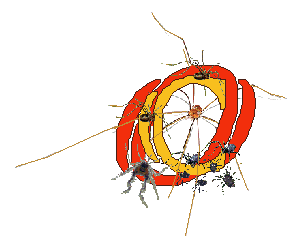Communities of Harvestmen
1: General
A consideration of Community Properties
and various indices to describe them.


Communities of Harvestmen1: GeneralA consideration of Community Properties
|
 |

|
A single-species population can be described in terms of its abundance (numerical or biomass), perhaps relating this to unit area (density) and making comparisons over space (habitat or range) and time (phenology). With a multi-species community, as well as sheer abundance (N = Σni, for i = 1 to S) there are additional features which can be described, notably depending on the number of species (species richness, S) and the relative abundances of the various species (evenness, E) and resultant species diversity. The latter term refers to the possibilities for complex biological interactions that depend on the mix of species making up a community and much community ecology is concerned with estimating parameters to quantify species diversity (e.g Hurlbert, 1971). A consideration of evolutionary aspects is provided by Magurran & May (1999).
Species richness (S) alone is insufficient as a descriptor because species diversity depends upon the distribution of individuals between the various species, i.e. evenness or equitability (E), being maximal when all species are equally abundant. Evenness can be calculated as E = (observed diversity)/(maximum diversity). If the community is dominated by particular species we can quantify the degree of dominance as D = Σpi2, where pi is the proportional abundance of species i (= ni / N). Two diversity indices proposed by Simpson (1949) both relate to D: B′ = 1 - Σpi2, and B = 1/Σpi2. The latter, Simpson's Inverse Index of Diversity, is conceptually useful with a maximal value of S when all species are evenly represented, so an observed value represents "the number of species that would effectively be present if they were evenly abundant/important".
A frequently used diversity index, derived from communication theory (Shannon, 1948; Shannon & Weaver, 1963), is the Shannon index, H = -Σ(pi . log pi), which estimates the uncertainty of identity of a random individual in the collection, and by extrapolation in the community. Based on similar principles, Brillouin’s (1956) index = (1/N).log2 (N!/(n1!.n2!…..ns!)), has also been used for opilionid communities. Several authors made some useful comparisons between diversity indices, e.g. Pielou (1966, 1974, 1977), Krebs (1978), May (1975), Uetz (1974), and also Magurran (1998). Curtis (1980) describes the influence of trap-type on some of these measures. It is also possible to use the parameter α from the logarithmic series as a diversity index (e.g. Docherty & Leather, 1997) and its performance in comparison to other indices is described by Wolda (1983).
The logarithmic parameter (α) should not be confused with α-diversity. For many years, ecologists have recognised different components in species diversity (e.g. Jaccard, 1912; Whittaker, 1960; MacArthur, 1965). In this paper concentration is placed on α-diversity, or local (point) diversity; often samples come from traps placed in a relatively small area and the community’s diversity is described in terms of the species recorded at that point in space. The extent to which species composition varies between different habitats (or even micro-habitats) is referred to as β-diversity. Given that harvestmen are generally mobile animals, capable of moving between habitat patches, there is in reality a link between α- and β-diversity. We can even extend this to γ-diversity, or the species diversity at a regional level; this will reflect the possibility of species moving into any sampled area and thus will have an influence on α-diversity. In our discussion here, we focus on α-diversity, but if you are interested in exploring β-diversity you could start with Koleff et al. (2003). Bell et al. (2000) consider the influence of environmental heterogeneity on species diversity, including a concise review of different possible mechanisms.
One of the problems in comparing communities is that sample size varies, and the observed species richness with it. This can be overcome by mathematically estimating the species richness for a standard sample size (Colwell, 1994-2000; Gotelli & Entsminger, 2003; Heck et al., 1975; Toti et al., 2000). This species/sample size consideration is similar to the species-area relationship, which is one of the major patterns in community ecology (Storch et al., 2003).
Graphical methods for describing community structure include species frequency curves using a plot of number of species with particular abundance values, i.e. S(n) against n, often on an octave scale (1, 2, 4, 8, 16…) (e.g. Curtis, 1978b, 1980; Curtis & Bignal, 1980). A second approach uses species importance curves (or dominance-diversity plot), in which the species are arranged along the x axis in decreasing order of abundance and the y axis is their abundance (ni). A steeply falling curve indicates low diversity, whereas a gently falling curve involving more species of moderate abundance indicates higher diversity (Freudenthaler, 1989, 1994b). A third method uses species accumulation curves, plotting the number of species recorded (species richness, S) against total number of organisms in each of the samples (sample size, N). The species accumulation curves from more diverse communities will show a steep rise of S with N, or a more gentle rise to a high asymptote, whereas a low-diversity community will quickly reach a low asymptote; if the curve fails to flatten off with increased sample size it suggests inadequate sampling or a community rich in rare, inconspicuous species. This approach features in Colwell’s (1994-2000) EstimateS software and for a recent good, concise treatment see Ugland et al. (2003). I prefer relatively straightforward, but biologically meaningful approaches. Simpson’s index, B, is easily appreciated intuitively as the equivalent species richness for the community if species were evenly abundant. If we consider species to be randomly mixing in the community, the complexity of possible species interactions can be calculated explicitly (Hurlbert, 1971) as the probability of interspecific encounter, PIE = (N/(N-1)).(1-Σpi2), clearly related to Simpson’s diversity index B′.
 Back to Opilionid Communities |
or |
 Back to Arachnologia |
 |
Back to Home page |